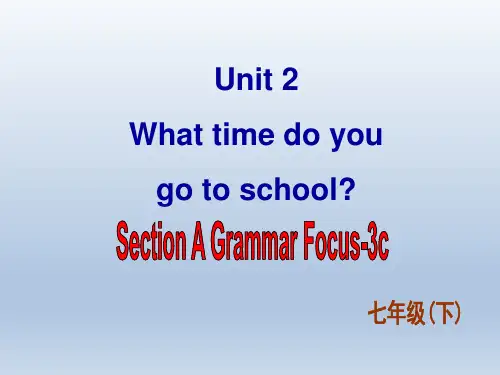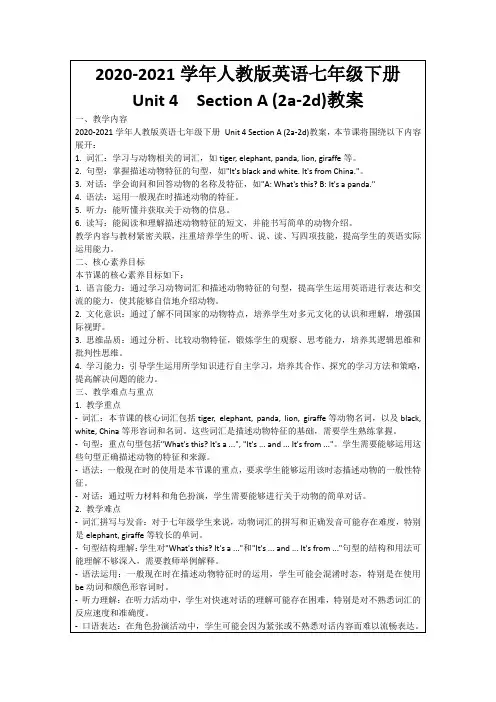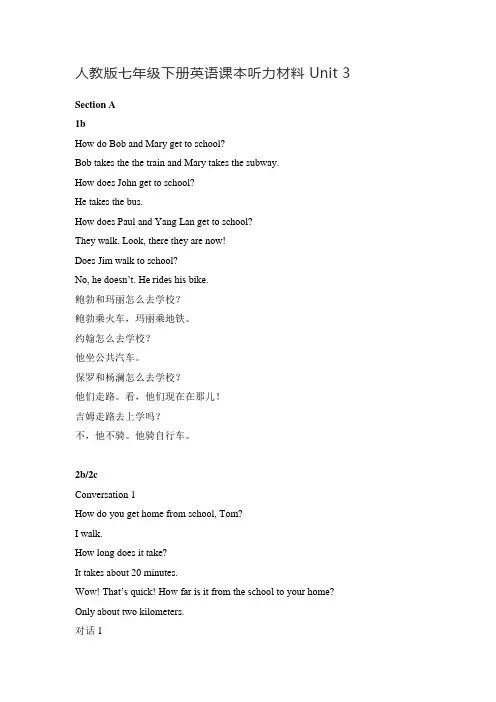人教版七年级下册英语教案书七年级下册英语听力mp3下载
- 格式:doc
- 大小:16.50 KB
- 文档页数:6

初中英语人教版(Go for it)七年级下册Unit1Can you play the guitar?教学设计第一课时(Section A1a--2d)【教学目标】Knowledge goals语言知识目标:1能掌握以下单词:guitar,sing,swim,dance,chess,play chess,draw,speak,speak English,join,club能掌握以下句型:①—Can you play the guitar?—Yes,I can./No,I can't.②—What can you do?—I can dance.③—What club do you want to join?—I want to join the chess club.2能了解以下语法:情态动词can的用法want to do sth.的用法Emotional goals情感态度价值观目标:该部分内容贴近学生的生活,谈论的话题是能力。
通过互相询问或谈论自己或对方在某一方面的能力,可以培养学生的一种群体意识。
【教学重难点】1.Teaching Importances教学重点:1)学习询问和谈论彼此的能力,特长和一些俱乐部的英语。
2)掌握一些弹奏乐器的表达方式。
2.Teaching Difficulties教学难点:情态动词can的构成和使用。
能准确表达出自己和组员的能力以及想加入的俱乐部【教学方法】直观教学法、情景教学、任务型教学法、自主探究教学法【教学工具】教学用具:电脑【教学过程设计】教学设计说明:本节课为这一单元的开始,重点在于一些乐器名称和俱乐部的教学,要求学生在学习完本节课时能准确表达出自己及小组成员的能力和特点,以及自己想要加入的俱乐部。
因此教学的过程着重点在于鼓励学生自主探究,小组合作学习,培养学生善于总结归纳知识,善于反思的品质。
设计主线为:新学期学校俱乐部招新,欣赏学生才艺展示。



新目标人教版英语七下全册教案(全英文版)Unit 1 Wheres your pen pal from?Language goals:•In this unit students learn to talk about countries, nationalities and Ian guages.•Ask and tell where people live.New languages:•Where's he / she from?•He / She is from Australia / England / China / France / Singapore / Australia. •Where does he / she live? He / She lives in Sydney.•What language do you speak? I speak English.•What's your / his / her favorite subject?•My / His / Her favorite subject is English.•Does he / she have any brothers and sisters? Yes, he/ she does. / No, he / she doesn't.Difficult points:1. Liste ning for the in formation about cou ntries, natio nalities and Ian guages. Write an e-mail about on eself. Describe the new stude nts in class.2. Where questions with fromWhere questions with liveWhat questi onsTeaching aids:• A tape recorderTeaching periods:•Period 1:Section A 中1a, 1b, 1c•Period 2:Section A 中2a, 2b, 2c, 2d•Period 3:Section A 中3a, 3b, 4•Period 4:Section B 中1,2a, 2b, 2c•Period 5:Section B 中3a, 3b, 3c, 4•Period 6:Self CheckPeriod 1Teaching aims:1. Teach vocabulary words.2. Target Ianguages:Where's your pen pal from?He is from Australia.3. Enable the students to learn to talk about nationalities.4. Help the students learn how to talk about nationalities.Teaching procedures:Step 1. Free talk2 Say: Do you have any friends? Where is she from?Help the students make the same sentences and give them more chances to say.Step 2. Talking about the picture (1a)Hold up the picture on page 1 and point at the map. Ask students toread the picture.Ask some of you to read them aloud to the class. Make the studentstalk about where people are from.Say: Du Chuan, where is your pen pal from?Ask the students to read the conversations in the picture.Step 3. Listening (1b)Point to the numbered list of words and play the recording for a secondtime.Ask the students to listen to the recording and circle the countries in 1a.Ask students to listen to and repeat after the recording and then checkthe answers.Step 4. Pair work(1c)1. Now work in pairs and read the conversations in 1a with your partner.You can talk about your own pen pal.2. Ask the students to look at their own clothes and the things in theirbackpack. Ask and answer questions about where they are from.Homework1. Ask the students to practice talking about where people are from and make up real dialogues.2. Learn the words in this unit (on page 115) by heart.Period 2Teaching aims:1. Learn the vocabulary words and useful expressions.2. Target languages: Where does he live? He lives in Toronto.3. Let the students learn to talk about where people live.4. Help the students learn how to talk about where people live.Teaching procedures:Step I.StepI RevisionCheck the homework. And then ask several students to answer questi ons.Say: Where are you from? Do you have a pen pal? Where is your pen pal from?Step 2. Presentation (2a)Put a map of the world on the blackboard.Say: What's the meaning of capital? Can you guess? Help them to answer.Write Australia, the United States, Canada, France, and Japan on theleft of the blackboard. And write Sydney, New York, Paris, Toronto, andTokyo on the right of the blackboard. And the teacher reads them aloudand asks students to repeat.Then ask students to match the cities with the countries.Step 3. Talk about countries and citiesAsk the students to work in pairs, asking about the cities and the countries.Say: Now work in pairs and ask where the city is. For example, the firststudent asks "Where is Beijing?” the second student answers “It's inChina."Then tell the students to ask question about Chinese cities.Step 4. Listening (2b, 2c)Tell the students to read the list of countries and cities in 2a.Say: Now let's look at the list of countries and cities in Activity 2a. I will ask some students to read them aloud to the class.Call the students' attention to the chart in 2c.Tell the students to listen to the conversations in Step 4 again to complete the chart.Step 5. Pair work(2d)Ask the students to read the conversations in the bubble. Then askthem to talk about the in formation in the chart in 2c.Then ask the students to work in groups and make up new dialogueswith their own information.Step 6.GrammarfocusReview the grammar box.Say: You have to pay attention the word "from". It always follows verb be, while live comes out alone in where sentences. Now make more sentences with where, from and live.Write the following on the blackboard.Say, now work in pairs and make dialogues after the model above.Homework1. Ask the stude nts to learn the sentence patter ns in Grammar Focus by heart. Try to use them freely.2. Remember the words in this unit (on page 115).3. Make a similar dialogue according to the conversation in 2d.Period 3Teaching aims:1. Teach vocabulary words.2. Target Ianguages: What Ianguage does she speak? She speaks English.3. Enable the students to learn to talk about what Ianguage people speak.4. Help the students to learn how to talk about what language people speak.Step 1. Free talkSay, Morning, boys and girls. Nice to see you again. Do you remember we have learned about how to ask where people are from and how to ask where people live? Now I want some of you to answer my questi ons.(Turn to a student.)Where are you from?Give more students chances to speak in class.Step 2. Presentation (3a)Say: Do you know the meaning of "Ianguage"? Listen: Tim is from England and he speaks English. So English is his Ianguage. I'm fromChina, so Chinese is my language .Now look at activity 3a.on page 3.Read the instructions to the class. Ask students to work in pairs as theyanswer the questions.Show the flowing and ask the students to make conversations after themodel.Step 3. Pair work (3b)Ask the students to pay attention to the conversation in Activity 3b.Say, Read the dialogue by yourselves. Then I will ask some pairs to act out the dialogue in class.Show a map of the world. Ask students to work in pairs.Step 4. Quiz(4)Ask the students to look at activity 4 then work in pairs and do the quiz.HomeworkAsk the students to work with their friends and practice the dialogue in activity 3b.Period 4Teaching aims1. Teach vocabulary words.2. Target languages:Does she have any brothers and sisters?Is that your new pen pal?Yes, it is.3. Enable the students to learn to talk about their new pen pals.4. Help the students learn how to talk about their new pen pals.Step 1. RevisionAsk the students to make conversations talking about their new pen pal.Ask some pairs to the front to talk about their pen pals. Greet each otherand have a free talk with classmates.Talk about the persons they admire.Step 2.Match work (1)Ask the students to pay attention to the notebook page with the countries listed.Ask the students to write the letter of the correct country in the box next to the title of each Ianguage textbook on the desktop.Step 3. Listening (2a, 2b)First, read the instructions and tell the students to read the conv ersati on bubbles.Check the answers. Then ask the students to read the questions again.Ask the students to fill in the chart.Give students 1 minute to finish the task. Check the answers with the stude nts.Then play the recording again and ask the students to repeat.Step 4. Pair work (2c)Ask two students to work in pairs, practicing the questions in activity 2a.Then tell the students to practice dialogues similar to the dialogue inactivity 2a in pairs. They can use their own names.HomeworkAsk the students to make up similar dialogues using the following words: Sam, the Unites Sates, New York, a brother and a sister, English and French.Period 5Teaching aims1. Teach vocabulary words.2. Target languages:I think China is a very interesting country.I like going to the movies with my friends and playing sports.My favorite subject in school is P.E.It's fun. / It's too difficult.3. Enable the students to write a pen pal letter.4. Help the students learn how to write to a pen pal.Step 1 .Warming upSay, Do you have a pen pal? Whafs his name? Does he have any brothers and sisters? What Ianguage does he speak?Then ask the students to work in pairs to talk about their pen pal.Step 2. Reading (3a)Ask the students to read the letter on page 5.Point the four questions beneath the letter.When the students finish reading the letter, ask the four questions orally and ask them to answer orally.Ask the students to retell the letter, using their own words.Step 3. Reading and writing (3b)Ask the students to pay attention to the letter from Tom King.Point out the blanks in the letter and the information card on the right.Correct the an swers. Then draw the in formation card on the blackboard and then ask the students try to retell the letter.Step 4. WritingAsk the students make their own information card.After they are finished, ask several students to read their e-mails in class.HomeworkAsk the students to choose one of the following tasks as homework.1. Show a name card to the students and ask them to write something about it.2. The students change their information card with their partner and writesomething about their partner.Period 6Teaching aims:1. Teach vocabulary words.2. Enable the students to describe the new students in the class.3. Help the students learn to describe the new students in the class.Teaching procedures:Step 1. RevisionPractice talking about one of the students.Say, Take out your information cards. And change it with your partner.Read it carefully and make up an oral practice, talking about yourpartner.Step 2.Key word checkAsk the students to read all the words in this part.Say: In learning to talk about where people are from, you learned many words on the topic. Now read and check the words you know in 1 on page6. Then say a sentence with each of them.Step 3.Vocab-BuildersAsk students to write five new words in their Vocabulary-Builder on page 112. After they are finished, ask two students to write their words down on the blackboard. And ask them to read the words and the whole class repeat. And tell the whole class to remember them after class.Step 4.WritingLet the students pay attention to the pictures.Say, Look at the picture of Sally. How old do you think she is? Where do you think she is from? What language do you think she speaks? What do you think she likes? What do you think she dislikes?The same step goes with Jim and Julie.After a few minutes, ask some students to read their descriptions to the class.Step 5.SpeakingAsk the students to do an oral practice about the new classmates.Say, There are several new students in our class this term. Who do youlike best? Why do you like him or her? Please tell us. First you can tellyour partner.Ask some students to present their work to the class.Step 6. Just for Fun!Ask all students to read the conversation.Let the students practice in pairs.HomeworkAsk the students to summarize what they have learned in this unit and prepare for the next unit.Unit 2 Where is the post office?Language goals:•In this unit students learn to talk about asking for and give directions on the street.New languages:•Excuse me, is there a bank near here?•Yes, there is. It's on Center Street.•Where is the pay phone?•lt*s across from / next to / in front of / behind the library.•lt*s between the post office and the library.•Just go straight and tum left.•Turn left on First Avenue.•Take a walk through the park on Center Avenue.•There is a clean / dirty park near my house.Difficult points:1. Listening for the information of the names of the neighborhoodRead the tour guide and an e-mail from a friend you're going to visitWrite the dialogues about asking the way and giving directions.2. Where questions.Affirmative statementsPrepositions of placeTeaching aids:• A tape recorder•Some picturesTeaching periods:Period 1: Section A1a, 1b, 1cPeriod 2: Section A2a, 2b, 2cPeriod 3: Section A3a, 3b, 4Period 4: Section B 1a, 1b, 1c, 2a, 2b, 2cPeriod 5: Section B 3a, 3b, 3c, 4Period 6: Self CheckPeriod 1Teaching aims:1. Teach vocabulary words.2. Target Ianguages: Is there a bank near here? Yes, there is. It's on CenterStreet.3. En able the stude nts to ask for and give di recti ons on the street.4. Help the students to ask for and give directions on the street.Teaching procedures:Step 1. Warming upShow three pictures prepared before class to the students. There is acat in a box in picture 1. There is a cat on a box in picture 2. There is acat under the box in picture 3.Then ask some students to ask and answer these questions.Step 2.Match work (2a)Ask the students to read the picture and the words in the numbered list.Ask the students to match each word or phrase on the list with one of the pictures.Then check the answers.Present the new sentence patterns.Then ask the students to read the dialogue in the picture.Step 3. Listening (1b)Ask the students to listen to the conversations and circle the places in 1a.Change the roles and do the same again.Then students ask and answer without the help of the recording.Step 4. PracticePoint to the different locations shown in the picture. Ask different students to name each one.Then point to more locations and let the students to practice more.Homework1. Practice the conversation in the picture on page 7.2. Learn the new words and phrases in this period by heart.Period 2Teaching aims:1. Learn the vocabulary words and useful expressions.2. Target languages:The pay phone is across from the library.The pay phone is next to the library.The pay phone is between the post office and the library.The pay phone is on Greet Street.The pay phone is in front of the library.The pay phone is behind the library.3. Enable the students to talk about the position of a place.4. Help the students to talk about the position of a place.Teaching procedures:Step 1. Revision and warming upCheck the homework by talking about the pictures on page 7 with thestudents or prepare some other pictures with different buildings in itand let the students practice asking and answering questions about theplaces.Ask the students to practice more.Step 2. Presentation (2a)Introduce the items across from, next to, between, in front of, behind and on.Draw the following picture on the blackboard.Park 3 Centre StreetEncourage or help the students to answer: It's across from the library.The same way goes with next to, on and in front of.Ask the students to match each sentence with one of the pictures.Then ask the students to read the six sentences and match thesentences the pictures.Check the answers.Step 3. Listening(2b)Review the buildings and street names in Activity 1a and the six sentences in 2a.The read the six sentences in 2b to the class.Ask the students to listen to the recording and fill in the blanks.Play the tape. Check the answers.Step 4. Practice (2c)Ask the students to repeat the conversations after the recording.Ask the students to do the Pair work asking and answering questions about the places in 1a.Step 5.Grammar FocusAsk the students to read the sentences in the grammar box aloud. The ask them to answer the following questions. Explain some Ianguage points if the students can't understand.Homework• Ask the students to practice talking about their neighborhood in pairs.Period 3Teaching aims:1. Teach vocabulary words.2. Target Ianguages:Just go straight and turn left.It*s down Bridge Street on the right.Ifs next to a supermarket.3. Enable the students to talk about the neighborhood.4. Help the students to talk about the neighborhood.Teaching procedures:Step 1. RevisionLet the students look at the picture in activity 1a. And ask some studentsto answer some questions in order to check the homework.Say, Is there a library near here? Where is it? Is there a bank near here?Where is it?Put up the picture of activity 2a on the blackboard and ask them to makeconversations.Step 2. Presentation (3a)Guide the students to guess the meanings of the three traffic signs. Show the pictures and ask some questions about the pictures.Then ask the students to hold up their left hands and then their right hands to practice “left” and "right".Point to the picture and let the students read the conversation.Ask the students to read the conversations. Then ask them to find Paul and Nancy in the picture.Ask the students to role play the conversation then point out the place that Paul wants to get to.Step 3. Complete the conversations (3b)Ask the students to make conversations and answer the questionsbelow each picture.The students point out the place in the picture. And write down theanswers on the line in the pictures. Or ask a pair of students to say theconversation, the others point to the speakers' place.Step 4. GameAsk the students to look at the picture in Activity 1a and name all thebuildi ngs.Ask some students to read the conversation in the picture in Activity 4.And then explain the instruction to the student.Then ask some groups to present their work.Homework• Ask the students to make a similar conversation to that in Activity 3a.Period 4Teaching aims:1. Teach vocabulary words.2. Target languages:Is there a big supermarket near your house?Yes, there is.There is a big supermarket.No! There is a small supermarket.3. Enable the students to describe the neighborhood.4. Help the students to describe the neighborhood.Teaching procedures:Step 1. RevisionCheck the homework by asking the following questions.Say, Look at the picture in activity 3a. Suppose you are standing nearthe building on the side of New Street. Please answer my questions.Excuse me. Is there a pay phone in the neighborhood?Ask another student to answer questions.Give more students chances to practice this dialogue.Step 2.Match work (1a)Bring in some objects or pictures to the students. (Two rulers, one is old, the other is new. Two boxes, one is big and the other is small. Two bottles, one is clean and the other is dirty. Two pictures of a street, one is busy and the other is quiet.)Say, Look at the rulers, please. Can you find the differenee between them?Yes. This one is old. (Show the old ruler.) And this one is new. (Show the new ruler.) Do you understand old and new?Ask the students to talk about the picture.Point to each half of each picture and ask about the differenee between the halves.Go on with the other pictures to teach the language items. Ask thestudents to match the words with the pictures.Step 3. Pair workCall attention to the conversation in the picture.Then ask the students to work in pairs and take turns asking each other questions about the things on the list of phrases in activity 1a on page 7.Step 4. Listening (2a, 2b)Ask the students to listen to the tape and circle the places in 1a.Say: Now please listen to the tape again. Listen to it and draw the places in Michael's neighborhood on the street map. Just listen.Play the recording.Play the recording again.Then have some students show their completed drawing to the class. Step 5. Pair workAsk the students to work in pairs talking about drawings to the class. Then ask some pairs to present their dialogues to the class.Ask the students to work in pairs, draw a map of their own neighborhood and practice asking and answering questions about the places they live in.Homework• Ask the students to make similar conversations to that in Activity 1 b.Period 5Teaching aims:1. Teach vocabulary words.2. Target languages:Turn left on First Avenue and enjoy the city's quiet streets and small parks.Take a walk through the park on Center Avenue.This is the beginning of the garden tour.Bridge is a good place to have fun.3. Enable the students to write a tour guide and draw the rout to somewhere.4. How to write a tour guide and draw the rout to somewhere.Teaching procedures:Step 1. RevisionCheck the homework by asking about the students neighborhood.Ask the students to work in pairs.Ask the students to work in pairs.Then ask some pairs to present their conversations to the whole class. Step 2. Reading (3a, 3b)Ask the students to read the tour guide.Divide the whole class into four groups to have a quiz.Tell the students to keep these words down and make at least twosentences with each word after class.After that ask the students to look at the pictures and fill in the blanks for this tour guide.Step 3.WritingAsk the students to write a tour guide with the students.Names of buildings and locations.Description wordsWords that talk about positions.Words that talk about di recti ons.Step 4. Pair work (4b)Learn to draw a picture of neighborhood. First ask the students toanswer the questions according to the pictures.Then ask the students to draw a picture according to the following conversati on.Then ask students to present their drawings to the whole class.Homework1. Ask the students to talk about the street and buildings in their own neighborhood.2. Ask the students to make sentences with the description words they keptdown in the class.Period 6Teaching aims1. Teach vocabulary words.2. Target Ianguages:I know you are arrivi ng n ext Sun day.Let me tell you the way to my house.I hope you have a good trip.3. Enable the students to write about the neighborhood.4. Help the students to learn how to write about the neighborhood.Teaching procedures:Step 1. RevisionCheck the homework by asking and answering some questions.Give more students chances to practice.Step 2.Key word check(1)Ask the students to check the words they know.Then ask the students to do the some exercises.Step 3.Vocab-Builders (2)Expand the students' vocabulary.After that ask the students to share their list with other students.Step 4. ReadingAsk the students to read the letter and draw the rout on the map.Ask the students to change the letter into a telephone conversation.Let the students pay attention to the pictures.Say, Look at the picture of Sally. How old do you think she is? Where do you think she is from? What language do you think she speaks? What do you think she likes?What do you think she dislikes?The same step goes with Jim and Julie.After a few minutes, ask some students to read their descriptions to the class.Step 5. Just for Fun!Call attention to the conversation in the cartoons.Ask the students to read the conversation and then answer the questi ons.Homework• Ask the students to do the following:1. Suppose your frie nd is going to visit you. He does n't know the way toyour house. Write a letter to him to tell him the route from the bus stop to your house.2. Review the next unit.Unit 3 Why do you like koalas?Language goals:•In this unit students learn to describe animals and express preferences.New languages:•Let's see the pandas first.•Why do you like want to see the pan das?•Because they are very cute.•Because they*re kind of shy.•Because they're kind of interesting.•Because they are fun.•Because they are smart.•Do you like giraffes?•Where are lions from?•They are from South Africa.•The animal is ugly / beautiful / friendly / small / shy / clever / cute / scary. •She likes to play with her friends and eat grass.•She's very beautiful, but she's very shy, so please be quiet•He sleeps during the day, but at night he gets up and eats leaves.Difficult points:1. Listening for the names of animals. Listen for the description words about animals.2. Read the description words about animals. Write about the animal you know.3. why, what, where questions, because, adjectives of qualityTeaching aids:• A tape recorder•Some picturesTeaching periods:•Period 1: Section A1a, 1b, 1c•Period 2: Section A2a, 2b, 2c•Period 3: Section A3a, 3b, 4•Period 4: Section B 1a, 1b, 1c, 2a, 2b, 2c•Period 5: Section B 3a, 3b, 3c, 4• Period 6: Self CheckPeriod 1Teaching aims:1. Teach vocabulary words.2. Target languages:Let's see the pan das.Why do you want to see the lions?Because they*re cute.3. Enable the students to talk about animals.4. Help the students learn how to listen to and talk about animals.Teaching procedures:Step 1. Warming upTalk about animals using pictures.Teach new words about animals by the pictures.Step 2.Match work (1a)Ask the students to read the words and the picture, and then match thenames with the pictures a-h.Encourage or help the students to say something about the picture anddo the match work.Step 3. Listening (1b)Point to the numbered list of words in activity 1a and play the recording.Ask the students to listen to the recording and circle the countries in 1a.Play the tape and then check the answers.Ask the students to listen to and repeat after the recording and thencheck the answers.Further activity: Ask the students to do some pair work in the followingway if they can understand the listening material well.Step 4. Pair work (1c)Ask the students to make conversations in pairs.Show the following.—Let's see the pan das / giraffes / lions / penguins / dolphi ns / koalas / elepha nts / tigers?—Why?——Because they're cute / interesting / fun / interesting / smart.Say: Now please make conversations in pairs, using the animals in activity 1a and the description words in activity 1c.Homework1. Ask the students to remember the new words in this period (on page 116) by heart.2. Ask the students to practice the conversation in activity 1 c.Period 2Teaching aims:1. Learn the vocabulary words and useful expressions.2. Target languages:I like dolphins.Why do you like dolphins?Because they are kind of interesting.3. Enable the students to talk about animals and tell why they like them.4. Help the students learn to talk about animals and tell why they like them. Teachi ng procedures:Step 1. Free talk and lead-inRevise the names of the animals.Say: In last period we learnt the names of some animals. Now let's do some revision. Please look at the pictures one by one and you have to tell me the name of the animal in the picture. OK?Show the students the animal pictures one by one.Revise the conversation learnt in the last period.Give more chances to more students to practice talking about the animals and expressing why they like the animals.Step 2. Listening (2a, 2b)First ask the students to listen and fill in the chart in activity 2a.Play the recording for the first time. Ask the students to listen carefully and write down the animals.Play the tape the second time.Ask the students to pay attention to the words in the box in Activity 2b.Ask the students to pay attention to the conversation in activity 2b. After that, check the answers.Then ask the students to listen to and repeat the dialogue after therecording.After this, ask the students to practice the conversation without the help of the recording.Step 3. Pair work (2c)Ask the students to work in pairs, ask and answer about animals they know.Ask the students to practice: Why? Because they are...Step 4.GrammarfocusAsk the students to read the sentences in the grammar box and sum up the sentence structure.Practice suggest!on: Ask the students to work in groups and write down。

初一七年级下册英语高清电子教科书-人
教版
本文档为初一七年级下册英语高清电子教科书的内容概述。
该教科书由人教版出版,是初一七年级下学期的英语教材。
书籍概述
- 该教科书是初一七年级下学期的英语教材,适用于学生研究英语基础知识和提升英语能力。
- 教科书内容包括单元主题、单元词汇、语法知识、听力练、阅读理解等。
- 教科书采用高清电子版形式,方便学生在电子设备上进行研究和阅读。
教科书特点
- 简洁易懂:教科书内容简洁明了,适合初一七年级学生理解和掌握。
- 重视听力训练:教科书中包含丰富的听力练,帮助学生提升
听力理解能力。
- 强调阅读理解:教科书中的阅读材料涵盖多种主题,帮助学
生培养阅读理解和分析能力。
使用建议
- 学生可以通过电子设备阅读教科书内容,方便随时随地进行
研究。
- 学生应按照教科书的研究顺序进行研究,逐步掌握英语知识。
- 学生可以利用教科书中的听力练和阅读理解题目进行自主练。
以上是对初一七年级下册英语高清电子教科书的简要介绍,希
望对您有所帮助!。


新人教版七年级英语下册全册教案Unit 1 Can you play the guitar?Section A (1a-2d)一、教学目标:1. 语言知识目标:1) 能掌握以下单词:guitar, sing, swim, dance, chess, play chess, draw, speak, speak English, join, club 能掌握以下句型:①—Can you play the guitar? —Yes, I can./ No, I can't.②—What can you do? —I can dance.③—What club do you want to join? —I want to join the chess club.2) 能了解以下语法:情态动词c an 的用法want to do sth.的用法2.情感态度价值观目标:的某一方面己或对方在该部分内容贴近学生的生活,谈论的话题是能力。
通过互相询问或谈论自能力,可以培养学生的一种群体意识。
二、教学重难点1. 教学重点:1) 学习询问和谈论彼此的能力和特长;2) 掌握一些弹奏乐器的表达方式。
2. 教学难点:c an 的构成和使用。
情态动词三、教学过程Ⅰ. Lead in1. 教师可携带一些易于演奏的乐器,也可带一些演奏乐器的图片,一边演示乐器,一边说:I can playthe guitar.⋯等;再指着图片说:He/She can play the violin .But I can ’t pl.a y等it;然后询问学。
生:Can you play the guitar? .⋯并引导学生进行简单的回答2. S s look at the picture in 1a. Then read the words and phrases. Let Ss match the activities with thepeople.Then Check the answers with the class together.Ⅱ. Presentation出示一些反映各种活动的图片、幻灯片或播放课件,引导学生谈论活动:He/She can dance/swim/sing/" ··But I can ’/t s d w a n i m c e/sing/...等,学习表达活动的动词短语。

人教版七年级下册英语课本听力材料Unit 3Section A1bHow do Bob and Mary get to school?Bob takes the the train and Mary takes the subway.How does John get to school?He takes the bus.How does Paul and Yang Lan get to school?They walk. Look, there they are now!Does Jim walk to school?No, he doesn’t. He rides his bike.鲍勃和玛丽怎么去学校?鲍勃乘火车,玛丽乘地铁。
约翰怎么去学校?他坐公共汽车。
保罗和杨澜怎么去学校?他们走路。
看,他们现在在那儿!吉姆走路去上学吗?不,他不骑。
他骑自行车。
2b/2cConversation 1How do you get home from school, Tom?I walk.How long does it take?It takes about 20 minutes.Wow! That’s quick! How far is it from the school to your home? Only about two kilometers.对话1汤姆,你放学怎么回家?我走路。
需要多长时间?大约需要20分钟。
哇!太快了!从学校到你家有多远?大约只有两公里。
Conversation 2How do you get home from school, Jane?I take the bus.How long does it take?Oh, about one hour and 30 minutes. Wow! That’s a long time!Yes , I only go home on weekends.How far is it from your home to school? It’s about 60 kilometers.对话2简,你怎么从学校回家的?我坐公共汽车。

课题名称:Unit 4 How do you make a banana milk shake?Section A 1a-1c一、教学设计指导思想和理论依据《英语新课程标准》注重培养学生学习英语的兴趣,树立自信心,培养学生良好的学习习惯,运用有效的学习策略培养学生自主学习能力和小组合作精神。
遵循学生的认知规律,从单词——句子——情景对话入手,围绕目标语言,由浅入深、由易到难的完成教师设计的任务,使学生在完成任务的过程中不仅从听说等方面掌握目标语言,而且在这过程中不断思考、有所创新。
利用多媒体和网络技术为学生创设真实可视的英语学习环境,激发学生积极参与的欲望,体现了学生的主体地位。
努力实现《英语新课程标准》语言教育理念是:知识用于行动,强调语言应用,培养创新实践能力,发展学习策略。
二、教学背景的分析1.教学内容分析本课是新目标英语七年级下册第四单元第一课时,教材以How do you make a banana milk shake?为中心话题。
本单元是一个有兴趣,愉悦的话题,无疑还会提高学生运用英语的兴趣和交际能力。
本节课是围绕“如何制作香蕉奶昔”为话题展开的,我们在前面已经学习了一些祈使句的用法,因此本单元是对祈使句的深化和延深,通过讲述制做过程和步骤,如何听懂指令、通过听与说的训练,学会准确地判断指令,有序地处理事情,学习运用顺序词,通过动手实际操作,培养和锻炼学生生活能力。
2.学情分析本课的教学对象为七年级46名学生,女生所占比重较大,女生英语学习水平总体较男生好,但男生课堂活动参与度较高,有一部分学生在英语学习上还有很大困难,因此在课堂上有部分学生不敢举手或者很少回答老师的问题,因此在课堂活动中分配小组成员时注重男女比例和分层教学。
七年级学生对英语感到有趣好奇,上课时我多以简单的口语知识作为切入点,让学生更易接受,从熟悉的内容转到新内容的学习,做到过渡自然。
对于学过的内容也可能没有完全掌握,则可以花时间较完整地复习学过内容,然后才学习新知识。


(此文档为word格式,下载后您可任意编辑修改!)Unit 1 Where’s your pen pal from?一、单元教材分析本单元的中心话题是pen pals。
主要语言功能项目是talk about countries, cities and languages。
语法结构为Where...from; Where (iv)and what language…speak。
先以Activity1复习语言与国家的配对练习入手,Activity2a, 2b一个综合的听力训练来展示学生的听力能力,并以听力内容为基础,通过Activity2c中假设的两人对话操练来培养学生的交流能力,同时也引导学生多沟通与多交流。
Activity3a是一篇email形式的阅读文章,并有相关问题由学生在阅读后进行回答Activity3b 是根据提供的信息进行填空的写作练习,Activity3c是一篇模仿写作,让学生给自己的笔友写一封关于本人信息的email。
我在各课时教学中设计各种各样的小活动,通过Discussion,Classifying,Guessing等不同方式让学生掌握本单元的知识点,用学会的知识与外国的笔友自如的交谈是学习本单元的目的。
二、教学目标分析1、语言目标a. 重点词汇:Countries: Canada, China, France, Japan, the United States,Singapore, Australia, The United Kingdom,Paris.Cities: Sydney, New York, Toronto, Toyo, London Languages: English, French, Japanese, Chinese.b. 重点句型:-Where…from? -She’sHe’s from…-Where does…live? -SheHe lives in …-What language does she A 1a—2dPeriod 2 Section A 3a—Section B2cPeriod 3 Section B 3a---3cPeriod 4 Summing up Section A and B and the grammar.五、教学过程设计The First PeriodTeaching aims:1.Learn to express the main countries and cities.2.Know something about the countries.3.Master where- sentence structure.Key points:1. Words: pen pal, Australia, Japan, Canada, France, the United states,Singapore, the United Kingdom, country, Sydney, NewYork, Paris, Toronto, Tokyo world2.Sentences: -Where is your pen pal from? -He’s from Australia.-Where does Paris-Where is John’s pen pal from ?Teaching aids:Some cards with cities and countries.Teaching procedures:Step 1.Lead—in (1a&2a)First greet the students. Then teacher begins the topic with the Spring Festival. Do you use the fresh pictures through computer to teach the students names of countries, cities. Divide the students into groups, then show the flags and pictures, let them guess the names of countries and cites. At last finish 2a on page2. 通过这个环节,教师完成本单元的新单词的导入,通过提供给学生每个国家的地图,让学生猜出国家名称及相应的城市,学生能有意识的记忆国家及城市的名称,并为整节课任务的完成奠定最基本的词汇基础。
人教版初中英语单词大全七八九年级(带音标)+mp3听力音频下载本资料包含人教版初中英语单词表七年级上册(带音标)和配套的mp3音频,人教版初中英语单词表七年级下册(带音标)和配套的mp3音频,人教版初中英语单词表八年级上册(带音标)和配套的mp3音频,人教版初中英语单词表八年级下册(带音标)和配套的mp3音频,人教版初中英语单词表九年级全一册(带音标)和配套的mp3音频。
七下Unit 3trainn.火车[treɪn]七下Unit 3busn.公共汽车[bʌs]七下Unit 3subwayn.地铁['sʌbweɪ]七下Unit 3take the subway乘地铁七下Unit 3ridev.&n.骑;旅程[raɪd]七下Unit 3biken.自行车[baɪk]七下Unit 3ride a bike骑自行车七下Unit 3sixtynum.六十[ˈsɪksti]七下Unit 3seventynum.七十[ˈsevənti]七下Unit 3eightynum.八十[ˈeɪti]七下Unit 3ninetynum.九十[ˈnaɪnti]七下Unit 3hundrednum.一百['hʌndrəd]七下Unit 3minuten.分钟['mɪnɪt]七下Unit 3faradv.&adj.远;远的[fɑː]七下Unit 3kilometer (=kilometre)n.千米;公里七下Unit 3newadj.新的;刚出现的[njuː]七下Unit 3everyadj.每一;每个['evri]七下Unit 3every day每天七下Unit 3byprep.(表示方式)乘(交通工具)[baɪ]七下Unit 3by bike骑自行车七下Unit 3drivev.开车[draɪv]七下Unit 3carn.小汽车;轿车[kɑː]七下Unit 3livev.居住;生活[lɪv]七下Unit 3stopn.车站;停止[stɒp]七下Unit 3think of认为七下Unit 3crossv.横过;越过[krɔːs]七下Unit 3rivern.河;江['rɪvə]七下Unit 3manyadj.&pron.许多['meni]七下Unit 3villagen.村庄;村镇['vɪlɪdʒ]七下Unit 3betweenprep.介于……之间[bɪ'twiːn]七下Unit 3between…and…在……和……之间七下Unit 3bridgen.桥[brɪdʒ]七下Unit 3boatn.小船[bəʊt]七下Unit 3ropewayn.索道七下Unit 3yearn.年;岁[jɪə]七下Unit 3afraidadj.害怕;畏惧[ə'freɪd]七下Unit 3likeprep.像;怎么样[laɪk]七下Unit 3villagern.村民['vɪlɪdʒə]七下Unit 3leavev.离开[liːv]七下Unit 3dreamn,&v.梦想;睡梦;做梦[driːm]七下Unit 3trueadj.真的;符合事实的[truː]七下Unit 3e ture实现;成为现实七下Unit 4rulen.规则;规章[ruːl]七下Unit 4arrivev.到达[ə'raɪv]七下Unit 4(be) on time准时七下Unit 4hallwayn.走廊;过道['hɔːlweɪ]七下Unit 4halln.大厅;礼堂[hɔːl]七下Unit 4dining hall餐厅七下Unit 4listenv.听;倾听['lɪsn]七下Unit 4listen to…听……七下Unit 4fightv.&n.打架;战斗[faɪt]七下Unit 4sorryadj.抱歉的;难过的;惋惜的[ˈsɒri]七下Unit 4outsideadv.&adj.在外面;外面的['aʊt'saɪd]七下Unit 4wearv.穿;戴[weə]七下Unit 4importantadj.重要的[ɪm'pɔːtənt]七下Unit 4bringv.带来;取来[brɪŋ]七下Unit 4uniformn.校服;制服[ˈjuːnɪfɔːm]七下Unit 4quietadj.安静的['kwaɪət]七下Unit 4outadv.外出[aʊt]七下Unit 4go out外出(娱乐)七下Unit 4practicev.&n.练习['præktɪs]七下Unit 4dishn.碟;盘[dɪʃ]七下Unit 4do the dishes清洗餐具七下Unit 4beforeprep.&adv.在……以前;以前[bɪ'fɔː]七下Unit 4make (one's) bed铺床七下Unit 4dirtyadj.脏的['dɜːti]七下Unit 4kitchenn.厨房['kɪtʃɪn]七下Unit 4moreadj.&pron.更多(的)[mɔː]七下Unit 4noisyadj.吵闹的['nɔɪzi]七下Unit 4relaxv.放松;休息[rɪ'læks]七下Unit 4readv.读;阅读[riːd]七下Unit 4terribleadj.非常讨厌的;可怕的['terəbl]七下Unit 4feelv.感受;觉得[fiːl]七下Unit 4strictadj.严格的;严厉的[strɪkt]七下Unit 4be strict (with sb)(对某人)要求严格七下Unit 4rememberv.记住;记起[rɪ'membə]七下Unit 4followv.遵循;跟随[ˈfɒləʊ]七下Unit 4follow the rules遵守规则七下Unit 4luckn.幸运;运气[lʌk]七下Unit 4keepv.保持;保留[kiːp]七下Unit 4hairn.头发;毛发[heə]七下Unit 4learnv.学习;学会[lɜːn]。
七年级下册英语教案人教版(优秀6篇)七年级英语下册教学计划篇一一、本学期的指导思想本人在本学期的英语教学中,坚持以下理念的应用:1、要面向全体学生,关注每个学生的情感,激发他们学习英语的兴趣,帮助他们建立学习的成就感和自信心,培养创新精神;2、整体设计目标,体现灵活开放。
3、突出学生主体,尊重个体差异;4、采用任务型的教学模式,让学生在老师的指导下通过感知、体验、实践、参与和合作等方式,实现任务的目标,感受成功;5、注重过程评价,促进学生发展,建立能激励学生学习兴趣和自主学习能力发展的评价体系。
二、教材分析本书每个单元都列出明确的语言目标、主要的功能项目与语法结构、需要掌握的基本词汇,并分为A和B两部分。
A部分是基础的语言内容,B部分是知识的扩展和综合的语言运用。
对于我们学生来说,由于小学基础不好,到初中以后学起来的确有些吃力,尤其是一千多个单词的记忆和简单的语法就吓退了不少学生学习英语的兴趣。
但我们必须知难而上,坚守教师职责,实实在在为英语教学成绩而努力。
三、教学目标对英语学习表现出积极性和初步的自信心。
能尝试使用适当的学习方法,克服学习中的困难。
常用的训练活动有以下几项:(1)Daily report:值日生介绍自己、家庭成员或朋友的情况,其它学生可互相提问题,询问个人职业。
(2)Play a guessing game:用问题“what does he do?”引入任务,让学生猜测多媒体课件中人物的职业,以此激发学生的学习兴趣,并训练学生的发散思维能力。
(3)Ask the way :创设问路情景,根据实际情况telling the way,eg. I want to go the hospital 完成对话活动。
通过训练把课内的语言学习与课外的语言活动结合起来,改变了过去老师一言堂的模式,变学生为主体,课堂主要是提供了一个学生获取知识的平台。
学生在活动中主动地获取知识。
四、具体实施方案1、加强词汇教学。
七下英语Unit1 Section A(Period 1)导学案【自学提示】进门测通过预习,翻译下列单词和短语。
1.吉他______________2.唱歌_________3.游泳_________4.跳舞_________5. 画画_______6.国际象棋_______7.参加__________8.说英语_____________ 【知识点】1.Can you play the piano? 你会弹钢琴吗?本句句型为Can you...? 意为“你会……吗?”,肯定回答用Yes, I can.否定回答用No, I can't.。
例如:—Can you sing? 你会唱歌吗?—Yes, I can./No, I can't.是的,我会。
/不,我不会。
注意:play the piano(弹钢琴)中的the不能省略,因为在“西洋乐器”前必须加定冠词。
而在play chess(下棋)中则不用定冠词the,因为在“棋类名词”前无须加定冠词。
2. join 常见的用法:(1)join“参加(某个组织或团体,成为其成员)”。
例如:—May I join the League? 我可以入团吗?—Certainly.当然可以。
(2)join sb.“加入到某人当中”。
例如:If you plant trees tomorrow, may I join you? 如果你们明天植树,我可以加入你们吗?(3)join in+活动“参加活动”。
例如:May I join in your conversation?我可以加入你们的谈话吗?当堂检测:一、单项选择。
1.Can you ______?A.play piano B.speaking English C.play the soccer D.play the guitar 2.She ______ sing, but she can dance.A.doesn't B.isn't C.can't D.don't3.My sister can't ______ in the river.A.sing B.run C.swim D.play4.—Can you play soccer? —______.It's hard.A.Yes,I can B.No,I can't C.No,I can D.Yes,I can't 5.They are Americans,but they can ______ Chinese.A.say B.tell C.speak D.talk二、根据所给的提示词,连词成句。
人教版七年级下册英语教案书七年级下册英语
听力mp3下载
人教版即由人民教育出版社出版,简称为人教版。
小学到高中都有这个版本的教材。
也是大多数学校所用的教材。
课堂能否进行高效率授课,学生与老师之间能否做到默契配合,教师能否让一节课的内容合理分布在课堂的每一个细节,这些都有赖于教师的教案设计是否符合学生的整体情况。
新人教版七年级英语下册教案(一)
unit
1 section b (3a-self check)
教学目标:
1.语言知识目标:
1) 复习询问或谈论自己或对方在某一方面的能力和特长,讨论参加某一个俱乐部。
2) 能够综合运用所学的知识,就自己的熟悉的内容来介绍自己或他人所俱有的能力及特长;
3) 总结回顾一些常见的一些表达人们能力的词汇,并能进行分类记忆。
2.情感态度价值观目标:
1) 能了解自己的一些特长,并运用自己的一技之长为他人或社会做一些有益的事情。
2)
新人教版七年级英语下册教案(二)
教学重难点
1.教学重点:
1)
2)能运用自己所学的相关英语语言知识,模仿所学过的相关材料来制作简单的广告。
2.教学难点:
的广告。
新人教版七年级英语下册教案(三)
教学过程
ⅰ.warmi ng-
up and revision
1.have
a dictation of the new words and expressions.
2.let
some ss retell what peter, alan and ma huan can do.
3.let
some ss to read the three ads again.
ⅱ.presentation
1.t:
who's he?
ss: he's liu huan.
t: what does he do?
ss: (help ss to answer) he's a famous musician.
write the words musician on the bb.
music 音乐 - musician音乐家
拓展: teach教-teacher老师
ⅲ.practice
1.t:
next week we'll have a music festival.so
we need some musicians to help with the music festival.i
wrote an ad
the box.
2.
ⅳ.writing
3.2b或3a中的广告的样子来写。
其次,为了使语气can you swim? can you...? 最后,一定记住将本次活动的联系方式写清楚。
4.teacher
walks around the classroom.give
any help ss may need.ask
one the students in each group to read aloud their ads to their class.let
other students in other groups give some advice on the ads.
5.decide
which ad is the best.
ⅴ.self
check
1
1.让学生们在小组内讨论这些分类的能力活动;每个小组成员积极发言,由小组长负责整理记录。
2.让某个小组的小组长说出他们小组整理的答案,再由其他小组成员进行补充;最后,将一份完整的能力活动分类总结表写在黑板上让同学们进行借鉴与补充。
3.give
ss a few minutes to remember the abilities.
ⅵ.self
check
2
1.tell
ss what they should do.you
can add as many words as you can to make phrases.give ss an exle: play the drum, play the piano, play the violin, play the guitar; play chess, play volleyball...
2.ss
work in groups.try
to make as many phrases as they can.they
should write down their phrases on their notebook.
3.let
some ss read their phrases.let
other students add more phrases.
ⅶ.self
check 3
1.now
you can write something you like.e.g.
what can you do? what can't you do? what about your family members, your friends, your classmates.you can write at least five sentences.
first i'll give a model:
i can speak english.i
can play chess.i
can play basketball.but
i can't play the piano.i
can't play the violin.my
sister can play the violin.she
can play the guitar, too.
2.ss
write about something by themselves.
3.let
some ss read their sentences to the class. homework
1.review section b。